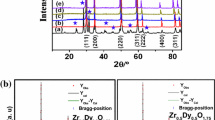Abstract
Much attention has been paid to barium zirconates because their high protonic conductivity and chemical stability are excellent properties for solid electrolytes. However, most studies have focused on highly doped materials such as 10 or 20 mol% Y-doped barium zirconates. In this study, the bulk and the grain boundary electrical properties of 1 mol% Y-doped barium zirconate are investigated as a function of temperature, water partial pressure, and oxygen partial pressure. At low temperatures and in wet atmospheres, the bulk of the barium zirconate predominantly conducts protonic defects, whereas, at high temperatures and in dry conditions, it is mixed oxygen ionic and electron-hole conducting. In the grain boundary, the protonic conductivity is a few orders of magnitude lower than the protonic conductivity in the bulk. In this study, possible causes for the low protonic conduction at the grain boundaries are considered.








Similar content being viewed by others
References
Norby T (1999) Solid State Ionics 125:1
Park HJ, Choa YH (2010) Electrochem Solid-State Lett 13:K49
Kreuer KD (1996) Chem Mater 8:610
Kreuer KD (2003) Annu Rev Mater Res 33:333
Nomura K, Kageyama H (2007) Solid State Ionics 178:661
Fabbri E, Pergolesi D, Licoccia S, Traversa E (2010) Solid State Ionics 181:1043
Azad AK, Savaniu C, Tao S, Duval S, Holtappels P, Ibberson RM, Irvine JTS (2008) J Mater Chem 18:3414
KjØlseth C, Fjeld H, Prytz Ø, Dahl PI, Estournes C, Haugsrud R, Norby T (2010) Solid State Ionics 181:268
Kuz’min AV, Balakireva VB, Plaksin SV, Gorelov VP (2009) Russ J Electrochem 12:1460
Yamazaki Y, Hernandez-Sanchez R, Haile SM (2009) Chem Mater 21:2755
Duval SBC, Holtappels P, Vogt UF, Stimming U, Graule T (2009) Fuel Cells 5:613
Wang JX, Su WH, Xu DP, He TM (2006) J Alloys Compd 421:45
Davis RA, Islam MS, Gale JD (1999) Solid State Ionics 126:323
Giannici F, Longo A, Kreuer KD, Balerna A, Martorana A (2010) Solid State Ionics 181:122
Bablio P, Haile SM (2005) J Am Ceram Soc 88(9):2362
Gao D, Guo R (2010) J Alloys Compd 493:288
Azad AM, Subramaniam S (2002) Mater Res Bull 37:11
Kreuer KD, Adams S, Münch W, Fuchs A, Klock U, Maier J (2001) Solid State Ionics 145:295
Bohn HG, Schober T (2000) J Am Ceram Soc 83:768
Park JY, Choi GM (2002) Solid State Ionics 154:535
Chen X, Rieth L, Miller MS, Solzbacher F (2009) Sens actuators B, Chem 137:578
Iguchi F, Sata N, Tsurui T, Yugami H (2007) Solid State Ionics 178:691
Bohn HG, Schober T, Mono T, Schilling W (1999) Solid State Ionics 117:219
Aoki M, Chiang YM, Kosacki I, Lee IJR, Tuller H, Liu YP (1996) J Am Ceram Soc 79:1169
Kreuer KD (1999) Solid State Ionics 125:285
Shi C, Yoshino M, Morinaga M (2005) Solid State Ionics 176:1091
Park HJ, Kim S (2007) J Phys Chem C 111:14903
Acknowledgment
I thank Prof. Sangtae Kim for the valuable discussions and study and Dr. Chan Kwak for the SOFC project.
Author information
Authors and Affiliations
Corresponding author
Appendix
Appendix
The \( {P_{{{{\rm{H}}_2}{\rm{O}}}}} \)-dependence of the protonic conductivity is defined as the ENC. I consider three cases.
-
(1)
ENC: \( 2\left[ {{\hbox{V}}_{\rm{O}}^{{ \bullet \bullet }}} \right] \approx \left[ {{\hbox{Y}}_{\rm{Zr}}^{\prime }} \right] \)
In this case, the protonic defect and the corresponding protonic conductivity strongly depend on the water partial pressure as shown below.
-
(2)
ENC: \( 2\left[ {{\hbox{V}}_{\rm{O}}^{{ \bullet \bullet }}} \right] + \left[ {OH_O^{ \bullet }} \right] \approx \left[ {{\hbox{Y}}_{\rm{Zr}}^{\prime }} \right] \)
In perovskite materials (ABO3), the site restriction is given by
Considering Eq. A3 and Eq. 4, the protonic defect can be estimated as following.
where S denotes an effective dopant concentration (Ref. 4). Thus, in this condition,
-
(3)
ENC: \( \left[ {{\hbox{OH}}_{\rm{O}}^{ \bullet }} \right] \approx \left[ {{\hbox{Y}}_{\rm{Zr}}^{\prime }} \right] \)
The protonic conductivity hardly depends on the water partial pressure owing to the fixed concentration of the acceptor.
Rights and permissions
About this article
Cite this article
Park, H.J. Electrical properties of the protonic conductor 1 mol% Y-doped \( {\hbox{BaZr}}{{\hbox{O}}_{{3 - \delta }}} \) . J Solid State Electrochem 15, 2205–2211 (2011). https://doi.org/10.1007/s10008-010-1237-z
Received:
Revised:
Accepted:
Published:
Issue Date:
DOI: https://doi.org/10.1007/s10008-010-1237-z




